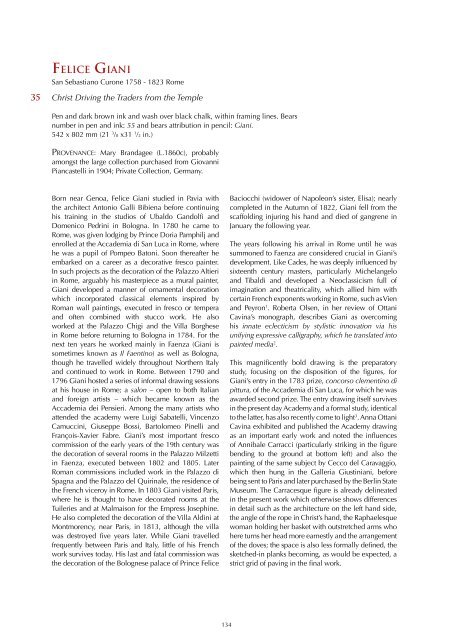Create successful ePaper yourself
Turn your PDF publications into a flip-book with our unique Google optimized e-Paper software.
Felice Giani<br />
San Sebastiano Curone 1758 - 1823 Rome<br />
35<br />
Christ Driving the Traders from the Temple<br />
Pen and dark brown ink and wash over black chalk, within framing lines. Bears<br />
number in pen and ink: 55 and bears attribution in pencil: Giani.<br />
542 x 802 mm (21 3 /8 x31 1 /2 in.)<br />
Provenance: Mary Brandagee (L.1860c), probably<br />
amongst the large collection purchased from Giovanni<br />
Piancastelli in 1904; Private Collection, Germany.<br />
Born near Genoa, Felice Giani studied in Pavia with<br />
the architect Antonio Galli Bibiena before continuing<br />
his training in the studios of Ubaldo Gandolfi and<br />
Domenico Pedrini in Bologna. In 1780 he came to<br />
Rome, was given lodging by Prince Doria Pamphilj and<br />
enrolled at the Accademia di San <strong>Luc</strong>a in Rome, where<br />
he was a pupil of Pompeo Batoni. Soon thereafter he<br />
embarked on a career as a decorative fresco painter.<br />
In such projects as the decoration of the Palazzo Altieri<br />
in Rome, arguably his masterpiece as a mural painter,<br />
Giani developed a manner of ornamental decoration<br />
which incorporated classical elements inspired by<br />
Roman wall paintings, executed in fresco or tempera<br />
and often combined with stucco work. He also<br />
worked at the Palazzo Chigi and the Villa Borghese<br />
in Rome before returning to Bologna in 1784. For the<br />
next ten years he worked mainly in Faenza (Giani is<br />
sometimes known as Il Faentino) as well as Bologna,<br />
though he travelled widely throughout Northern Italy<br />
and continued to work in Rome. Between 1790 and<br />
1796 Giani hosted a series of informal drawing sessions<br />
at his house in Rome; a salon – open to both Italian<br />
and foreign artists – which became known as the<br />
Accademia dei Pensieri. Among the many artists who<br />
attended the academy were Luigi Sabatelli, Vincenzo<br />
Camuccini, Giuseppe Bossi, Bartolomeo Pinelli and<br />
François-Xavier Fabre. Giani’s most important fresco<br />
commission of the early years of the 19th century was<br />
the decoration of several rooms in the Palazzo Milzetti<br />
in Faenza, executed between 1802 and 1805. Later<br />
Roman commissions included work in the Palazzo di<br />
Spagna and the Palazzo del Quirinale, the residence of<br />
the French viceroy in Rome. In 1803 Giani visited Paris,<br />
where he is thought to have decorated rooms at the<br />
Tuileries and at Malmaison for the Empress Josephine.<br />
He also completed the decoration of the Villa Aldini at<br />
Montmorency, near Paris, in 1813, although the villa<br />
was destroyed five years later. While Giani travelled<br />
frequently between Paris and Italy, little of his French<br />
work survives today. His last and fatal commission was<br />
the decoration of the Bolognese palace of Prince Felice<br />
Baciocchi (widower of Napoleon’s sister, Elisa); nearly<br />
completed in the Autumn of 1822, Giani fell from the<br />
scaffolding injuring his hand and died of gangrene in<br />
January the following year.<br />
The years following his arrival in Rome until he was<br />
summoned to Faenza are considered crucial in Giani’s<br />
development. Like Cades, he was deeply influenced by<br />
sixteenth century masters, particularly Michelangelo<br />
and Tibaldi and developed a Neoclassicism full of<br />
imagination and theatricality, which allied him with<br />
certain French exponents working in Rome, such as Vien<br />
and Peyron 1 . Roberta Olsen, in her review of Ottani<br />
Cavina’s monograph, describes Giani as overcoming<br />
his innate eclecticism by stylistic innovation via his<br />
unifying expressive calligraphy, which he translated into<br />
painted media 2 .<br />
This magnificently bold drawing is the preparatory<br />
study, focusing on the disposition of the figures, for<br />
Giani’s entry in the 1783 prize, concorso clementino di<br />
pittura, of the Accademia di San <strong>Luc</strong>a, for which he was<br />
awarded second prize. The entry drawing itself survives<br />
in the present day Academy and a formal study, identical<br />
to the latter, has also recently come to light 3 . Anna Ottani<br />
Cavina exhibited and published the Academy drawing<br />
as an important early work and noted the influences<br />
of Annibale Carracci (particularly striking in the figure<br />
bending to the ground at bottom left) and also the<br />
painting of the same subject by Cecco del Caravaggio,<br />
which then hung in the Galleria Giustiniani, before<br />
being sent to Paris and later purchased by the Berlin State<br />
Museum. The Carracesque figure is already delineated<br />
in the present work which otherwise shows differences<br />
in detail such as the architecture on the left hand side,<br />
the angle of the rope in Christ’s hand, the Raphaelesque<br />
woman holding her basket with outstretched arms who<br />
here turns her head more earnestly and the arrangement<br />
of the doves; the space is also less formally defined, the<br />
sketched-in planks becoming, as would be expected, a<br />
strict grid of paving in the final work.<br />
134
















